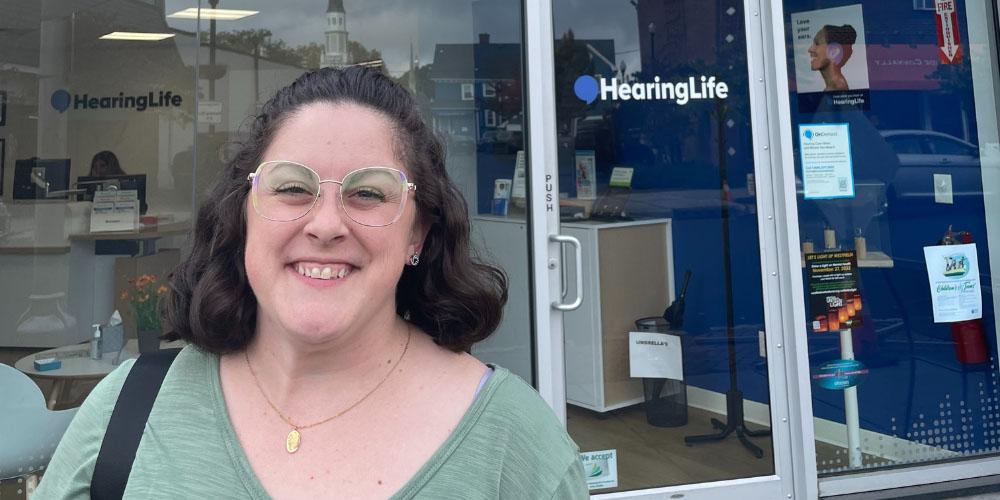
Hearing aid trends to watch in 2025
Advancements in technology continue to improve everyday devices, and hearing aids are no exception. Today’s hearing aids are equipped with features like BluetoothⓇ connectivity, noise reduction and AI-powered sound enhancements, making them more effective and user-friendly than ever before. These innovations change how people with hearing loss experience the world around them.
Want to know more? Read on for the hearing aid trends of 2025.
Connecting hearing aids to Alexa and smartphones
Hearing aids keep getting smarter, offering a more connected and convenient experience.
Some Bluetooth-enabled hearing aids allow you to connect hearing aids to Alexa devices or other hearing aid-compatible smart speakers. To make the connection, you’ll need both the smart speaker app and a hearing aid app for smartphones. Once you’ve made the connection, you’ll be able to give commands to your speaker and stream music, phone calls and more directly from your hearing aids.
As the popularity of smart home technology grows, expect more smart speakers and hearing aids to offer even more streamlined compatibility.
Enhanced hearing aid app control
Integrating hearing aids with smartphones, like iPhones or Android devices, opens a world of convenience and control for users.
With the Miracle-Ear hearing aid app, your phone becomes a powerful tool for your hearing aids. You can adjust volume, fine-tune sound settings and create custom profiles for different listening environments.
Bluetooth enabled, app-controlled hearing aids also enable direct streaming for clearer phone calls and enhanced music listening. Plus, you can manage appointments and track hearing aid usage right from your device.
Waterproof or water-resistant hearing aids
Durability is a top concern for hearing aid wearers, which is why we introduced the BLISS™ line of waterproof hearing aids.
Featuring HydroGuard™ technology, these devices are built with eight protective layers to withstand elements like sweat, rain, dirt and dust. Our water-resistant hearing aids can handle water exposure up to 1 meter deep, helping protect your investment from water damage.
This protection makes it easier to maintain an active lifestyle without worrying about unexpected rain or splashes while you’re enjoying the outdoors.
Small, rechargeable and discreet hearing aids for ultimate comfort
Comfort and aesthetic appeal continue to drive demand for hearing aids to become smaller, lighter and nearly invisible. Discretion is important for many wearers, and there are now many discreet hearing aids that fit effortlessly into daily life without being noticeable.
Small rechargeable hearing aids are evolving in exciting ways. In the past, many of the smallest hearing aids were simply too small to accommodate rechargeable batteries. But now, batteries have shrunk, making it possible to combine discreet appearance with rechargeable power. With a single overnight charge, you can enjoy a full day of vibrant sound that only you’re aware of.
Rechargeability across models
Advances in rechargeable hearing aids will continue to transform daily convenience and reliability for users.
While many behind-the-ear (BTE) and receiver-in-canal (RIC) hearing aids already offered rechargeable models, today rechargeable batteries are being built into smaller in-the-ear (ITE) styles of hearing aids as well (this includes some CIC and IIC styles).
Rechargeable Bluetooth hearing aids can provide up to 24 hours of use on a single charge; simply charge them overnight and you’re good to go for the next day.
Personalized hearing aids: custom treatments based on clinical data
Every year, new hearing technology opens further possibilities for people with hearing loss. With emphasis on individual needs, it’s increasingly popular to customize hearing aids for unique needs, preferences and lifestyles.
Customization can mean multiple things in this new world of hearing aids: it can refer to how hearing aids are physically made or how they function. Some of the smallest hearing aids are custom-fitted to wearers’ unique ear canals, while larger and more powerful models like BTEs can be fitted with custom earmolds that sit in the shell of the ear. Customizing technology, meanwhile, adapts to the wearer’s environment with automated adjustments that happen in fractions of a second. Advanced hearing aids also enable wearers to create and switch between customized programs and settings, fine-tuning your hearing with just a tap.
Today, if you want to personalize hearing aids, the sky’s the limit.
Teleaudiology: remote support
The use of telehealth in all kinds of medical treatment — including audiology, or teleaudiology — is an emerging trend. It allows for remote consultations and support, offering convenience for certain needs. But whether you’re on a virtual visit or a telephone call, it makes a difference to work with a team that truly knows your hearing.
Getting to know a hearing care professional (HCP) first with in-person visits helps ensure that you get the best results from future remote visits.
When you’re shopping for hearing aids in 2025, make sure that the options you’re considering offer sufficient services — both in-person and remote — to help you get started with your hearing aids and to support you throughout your hearing journey.
The above is the interpretation of The Future of Sound: 2025 Hearing Aid Technology Trends provided by Chinese hearing aid supplier Shenrui Medical. Link https://www.srmcm.com/Blog/The_Future_of_Sound_2025_Hearing_Aid_Technology_Trends.html of this article is welcome to share and forward. For more hearing aid related information, please visit Blog or take a look at our Hearing aids products















